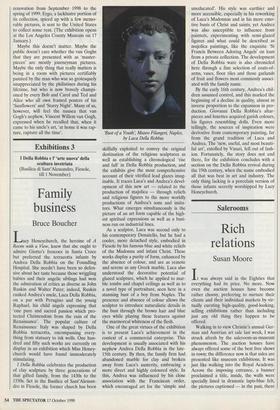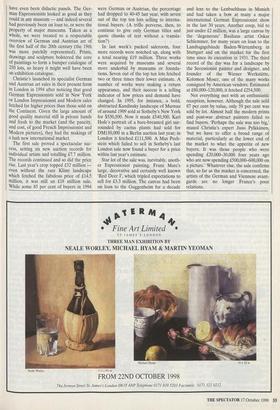Salerooms
Rich relations
Susan Moore
It was always said in the Eighties that everything had its price. No more. Now even the auction houses have become rather choosy, preferring to nurture their clients and their individual markets by vir- tually curating high-quality, good-looking, selling exhibitions rather than including just any old thing they happen to be offered.
Walking in to view Christie's annual Ger- man and Austrian art sale last week, I was struck afresh by the saleroom-as-museum phenomenon. The auction houses have always offered some of the best free shows in town; the difference now is that sales are presented like museum exhibitions. It was just like walking into the Royal Academy. Across the imposing entrance, a banner proclaimed a title, inside, the walls were specially lined in dramatic lapis-blue felt, the pictures captioned — in the past, there have even been didactic panels. The Ger- man Expressionists looked as good as they could in any museum — and indeed several had previously been on loan to, or were the property of major museums. Taken as a whole, we were treated to a respectable overview of German and Austrian art of the first half of the 20th century (the 19th was more patchily represented). Prints, drawings and sculpture bolstered the core of paintings to form a bumper catalogue of 250 lots, so heavy it might well have been an exhibition catalogue.
Christie's launched its specialist German and Austrian art sales in their present form in London in 1994 after noticing that good German Expressionists sold in New York or London Impressionist and Modern sales fetched far higher prices than those sold on the Continent. Given the large amount of good quality material still in private hands and fresh to the market (and the paucity, and cost, of good French Impressionist and Modern pictures), they had the makings of a lush new international market.
The first sale proved a spectacular suc- cess, setting six new auction records for individual artists and totalling £7.7 million. The records continued and so did the price rise. Last year's crop topped £32 million even without the rare Klimt landscape Which fetched the fabulous price of £14.5 million, it was still an £18 million sale. While some 85 per cent of buyers in 1994 were German or Austrian, the percentage had dropped to 40-45 last year, with seven out of the top ten lots selling to interna- tional buyers. (A trifle perverse, then, to continue to give only German titles and quote chunks of text without a transla- tion?) In last week's packed saleroom, four more records were notched up, along with a total nearing £19 million. Three works were acquired by museums and several more underbid by museums or founda- tions. Seven out of the top ten lots fetched two or three times their lower estimate. A number of works were making a return appearance, and their success is a telling indicator of how prices and demand have changed. In 1995, for instance, a bold, abstracted Kandinsky landscape of Murnau of around 1909 sold at Sotheby's New York for $530,500. Now it made £540,500. Karl Hofe's portrait of a bare-breasted girl sur- rounded by cactus plants had sold for DM150,000 in a Berlin auction last year; in London it fetched £111,500. A Max Pech- stein which failed to sell in Sotheby's last London sale now found a buyer for a price within last year's estimate.
Star lot of the sale was, inevitably, anoth- er Expressionist painting, Franz Marc's large, decorative and certainly well known `Red Deer I', which tripled expectations to sell for £3.3 million. The canvas had been on loan to the Guggenheim for a decade and lent to the Lenbachhaus in Munich and had taken a bow at many a major international German Expressionist show in the last 30 years. Another coup, bid to just under £2 million, was a large canvas by the 'degenerate' Bauhaus artist Oskar Schlemmer, for many years on loan to the Landtagsgebaude Baden-Wiirtemberg in Stuttgart and on the market for the first time since its execution in 1931. The third record of the day was for a landscape by the Secessionist painter and designer, and founder of the Wiener Werkstatte, Kolomon Moser, one of the many works consigned by American vendors. Estimated at £80,000-120,000, it fetched £254,500.
Not everything met with an enthusiastic reception, however. Although the sale sold 87 per cent by value, only 59 per cent was sold by lot. Almost half the modern prints and post-war abstract painters failed to fmd buyers. 'Perhaps the sale was too big,' mused Christie's expert Jussi Pyllckanen, `but we have to offer a broad range of material, particularly at the lower end of the market to whet the appetite of new buyers. It was those people who were spending £20,000-30,000 four years ago who are now spending £500,000-600,000 on a picture.' Whatever else, the sale confirms that, so far as the market is concerned, the artists of the German and Viennese avant- garde are no longer France's poor relations.











































































 Previous page
Previous page